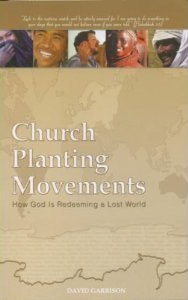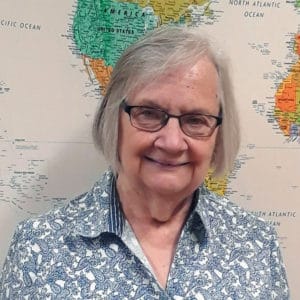Hundreds of churches are being planted within relatively few years and tens of thousands are coming to know Christ, in places and among people groups that most of us have never heard of. David Garrison calls these occurrences Church Planting Movements, and within the pages of his book by the same name he provides their stories and lessons the Church as a whole can learn from them.
- Title: Church Planting Movements: How God Is Redeeming a Lost World
- Author: David Garrison
- Publisher: Midlothian, VA: WIGTake Resources, 2004
- Pages: 304 plus additional resources
 Church Planting Movements is a book that will bring great encouragement to those in ministry who are at a low point in their lives and are unsure of the power of God as they weary laboring with little to show for it. However, it is primarily a book for those with a mission heart–whether across the seas or across the block. The book is divided into four parts, the second of which includes chapter after chapter of stories of how amazingly God is reaching the lost all around the world. Hundreds of churches are being planted within relatively few years and tens of thousands are coming to know Christ. Many of these converts are from people groups most of us have never even heard of. Isolated and relatively untouched by the Western world, these people groups have been touched by the Lord in miraculous ways, and they cannot help but start new churches, usually small house churches. But let’s start from the beginning.
Church Planting Movements is a book that will bring great encouragement to those in ministry who are at a low point in their lives and are unsure of the power of God as they weary laboring with little to show for it. However, it is primarily a book for those with a mission heart–whether across the seas or across the block. The book is divided into four parts, the second of which includes chapter after chapter of stories of how amazingly God is reaching the lost all around the world. Hundreds of churches are being planted within relatively few years and tens of thousands are coming to know Christ. Many of these converts are from people groups most of us have never even heard of. Isolated and relatively untouched by the Western world, these people groups have been touched by the Lord in miraculous ways, and they cannot help but start new churches, usually small house churches. But let’s start from the beginning.
Too often we begin by strategizing ourselves and, in essence, telling God how a ministry/mission should be approached, but Garrison wanted to see how God was doing the wonderful things he had been hearing about.
The first part of the book lays out for the reader how this study began. I was very impressed that the first thing the author and a team of “Strategy Coordinators” did was look at what God has already been doing. Too often we begin by strategizing ourselves and, in essence, telling God how a ministry/mission should be approached, but Garrison wanted to see how God was doing the wonderful things he had been hearing about. He describes the role of a Strategy Coordinator as “a missionary who takes responsibility for developing and implementing a comprehensive strategy–one that would partner with the whole body of Christ–to bring an entire people group to faith in Jesus Christ”.1 This is a very important role which ties in with his definition of a church planting movement which is “a rapid multiplication of indigenous churches planting churches that sweeps through a people group or population segment”.2 This definition does seem more usable and appropriate when focusing on unreached people groups or countries where open Christian worship is cause for persecution than it is for the Western world. Both this possible limitation and the wonderful selection of accounts in Part 2 from around the world testify to the well-documented fact that the center of Christianity has moved to the Two-thirds World (Asia, Africa, and Latin America) and away from Western Europe and North America. The examples of such movements from Europe tended to be with refugee groups or itinerant groups such as the gypsies. North American examples were not true examples as they were primarily mega-churches utilizing a large network of cell groups. The difference between these models and true church planting movements is explicated on pages 270-272 where the author responds to the commonly asked question, “What is the difference between cell churches and house churches, and how is each related to Church Planting Movements?”.3

The third part takes us from reviewing the wondrous methods of God and extrapolates various lessons to be learned. The author and the Strategy Coordinators honed down the information gleaned from the many examples and addressed the question, “How is God at work in these Church Planting Movements, and how can we join him?”4 In answer to this question, they came up with ten characteristics found in most, though not all, church planting movements, and seven barriers they unearthed that prevented a church planting movement from either beginning or continuing. A whole chapter was devoted to developing a biblical foundation for the ten characteristics found in every church planting movement.
The fact that both western Europe and the U.S. are entering a post-Christian era and there are increasing numbers of unchurched who have very little if any knowledge of the Bible should lead denominations to rethink “church” and try to learn from our brothers and sisters in other parts of the world.
I’m not a fan of lists of lessons or steps, but in this case I found each list extremely helpful, probably because they were descriptive and not proscriptive. Since my own mission work has been in U.S. inner cities among the marginalized, I could see the relevance in each of these lessons although at times in a somewhat altered form. Since there are no “unreached people groups” in large enough numbers in any one geographical area in the U.S., we may be looking at more multi-ethnic models that could still minister in appropriate “heart” languages. Also, since the U.S. is not encountering the Christ of the Bible for the first time, most people groups have at least had a taste of western style “Christianity” and may have been affected by that contact positively or negatively. The fact that both western Europe and the U.S. are entering a post-Christian era and there are increasing numbers of unchurched who have very little if any knowledge of the Bible should lead denominations to rethink “church” and try to learn from our brothers and sisters in other parts of the world. We need to think of reaching the lost in new ways.
The fourth part was my least favorite in that even though it was based on the three previous parts it provided helps that seemed too gimmicky to me. The whole idea of plotting gaps and then developing strategies to bridge those gaps seems to be taking a step backwards by taking descriptive lessons and now making them proscriptive so that the way God has greatly moved has to be the way He will continue to move. I do find it helpful to review the lessons from the third part as we evaluate our own mission, but I would do so to determine if the Lord is working in the same way in my context, not by using the lessons as a mold which my mission must fill. One piece in this part which I definitely agree with is that if we are looking for a miraculous movement of God, we must think about how to train leaders, especially if we see the need to move away from churches gathering large numbers in one location to have large numbers of small churches. The author’s idea of training trainers who would then train leaders who could then become trainers themselves is a helpful insight into how this could be handled.
Although I didn’t find the last part as appealing as the others, overall I believe this is a very important book that I wish everyone who has a heart to see transformed communities would read. I was mesmerized by it and was over and over again brought to a place of praising the Lord and worshiping Him for the grace He bestows on us.
Notes
1 Page 17.
2 Page 21.
3 Page 270.
4 Page 171.



1 thought on “Review: Church Planting Movements”
This is a great exploration on church planting which is increasingly becoming a critical subject in African cities particularly in relation to new emerging mission fields beyond traditional or conventional approach to mission. The challenge is to move away from a denominational view of church planting to embrace a multi-cultural approach. I like the book.